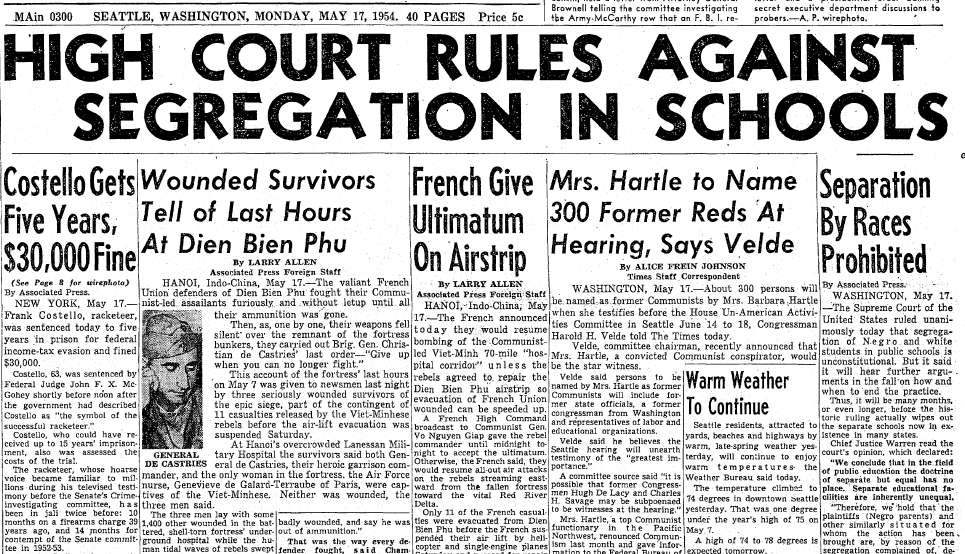School Desegregation: The Justice Department's Decision And Its Nationwide Impact

Table of Contents
The Legal Foundation of School Desegregation
Brown v. Board of Education (1954): A Landmark Ruling
The landmark Supreme Court case, Brown v. Board of Education, stands as a cornerstone in the fight for civil rights. This monumental Brown vs Board decision, handed down in 1954, declared state laws establishing separate public schools for black and white students to be unconstitutional. The ruling unequivocally rejected the "separate but equal" doctrine established in Plessy v. Ferguson (1896), which had previously legitimized racial segregation.
- The Court's central argument was that segregating children based on race inherently created a feeling of inferiority that negatively impacted the education and personal development of African American children.
- Despite the Brown vs Board ruling, the implementation of desegregation was met with significant resistance in many parts of the country, particularly in the South. Massive resistance, including school closures and legal challenges, delayed the desegregation process for years.
- Key figures involved in the case included Thurgood Marshall, lead attorney for the NAACP Legal Defense and Educational Fund, and Chief Justice Earl Warren, who wrote the unanimous opinion of the Court.
The Role of the Justice Department in Enforcement
The Justice Department, specifically its Civil Rights Division, played a crucial role in enforcing the desegregation orders stemming from Brown v. Board. This involved a multifaceted approach to overcoming resistance to desegregation rulings.
- The department employed various legal strategies, including filing lawsuits, issuing injunctions, and working with school districts to develop desegregation plans.
- While the Justice Department achieved notable successes in some regions, it also faced significant obstacles, including active defiance from state and local governments, as well as limited resources and political opposition to forceful enforcement. The Civil Rights Division had to navigate intense political pressure and legal challenges to implement the court’s ruling on school desegregation cases.
- Examples of successful interventions include court-ordered busing programs designed to integrate schools, while resistance often manifested in the form of "massive resistance" movements and the creation of private, segregated schools.
Nationwide Impact and Regional Variations
The South vs. the North: A Tale of Two Segregations
The implementation of desegregation differed dramatically between the Southern and Northern states. The South had a history of de jure segregation – segregation mandated by law – while the North experienced de facto segregation – segregation resulting from residential patterns and other factors.
- Southern states employed overt methods of segregation, including separate schools, facilities, and public spaces, making de jure segregation explicit and deeply entrenched. Overcoming this required significant legal intervention and federal enforcement.
- In contrast, Northern states faced de facto segregation, a more subtle but equally pervasive form of segregation, often rooted in housing patterns and discriminatory practices. This made tackling segregation more challenging as it lacked the clear legal basis of the South.
- Consequently, the success of desegregation varied widely. The South witnessed more dramatic shifts due to court-ordered interventions, while the North experienced slower, less comprehensive integration, and de facto segregation persisted.
Long-Term Effects on Education and Society
The legacy of segregation, or its incomplete dismantling, continues to have profound consequences for education and society. The resulting achievement gap significantly impacts educational equity, social mobility, and racial inequality.
- Statistical data consistently shows that students in predominantly minority schools often have lower test scores, graduation rates, and access to higher education compared to their peers in predominantly white schools. This reflects the persistent impact of school desegregation (or lack thereof).
- The persistence of segregation contributes to socioeconomic disparities, limiting opportunities for social mobility within marginalized communities. The effects extend far beyond the classroom and impact many facets of life.
- The impact on interracial relations and social cohesion is also considerable. The lack of integrated learning environments can perpetuate stereotypes and misunderstandings, hindering the development of inclusive and equitable communities.
Contemporary Challenges and Ongoing Debates
Resegregation and Modern-Day Inequalities
Despite the legal victories of the Civil Rights era, school segregation continues to be a significant challenge in the 21st century. Resegregation, fueled by factors such as residential segregation, school choice policies, and funding disparities, is creating increasingly homogenous school populations.
- Data reveals a resurgence of racial and socioeconomic segregation in many school districts across the nation, highlighting the ongoing need for proactive interventions.
- Socioeconomic factors play a crucial role, as families with greater resources often have more choices regarding where their children attend school, leading to self-segregation patterns. School choice policies, if not carefully designed, can exacerbate this issue.
- Unequal school funding exacerbates the disparities between integrated and segregated schools, providing fewer resources to schools with a higher concentration of minority students. This undermines the stated aim of ensuring educational equity.
The Future of School Desegregation
The fight for school integration continues, marked by ongoing legal battles and policy debates. Issues such as affirmative action and the effectiveness of different school integration strategies remain contentious.
- Current initiatives focus on promoting school diversity through various strategies, such as managed choice programs, magnet schools, and redrawing school district boundaries.
- These initiatives face significant legal and political challenges, with some arguing that such programs constitute reverse discrimination while others emphasize the need for affirmative measures to address historical injustices.
- Achieving truly equitable educational opportunities requires a multifaceted approach, addressing not only school assignment but also factors such as funding disparities, teacher quality, and curriculum development.
Conclusion
The Justice Department's role in enforcing school desegregation following Brown v. Board of Education was crucial but ultimately incomplete. While legal segregation ended, de facto segregation and its resulting inequalities persist. The legacy of segregation continues to affect educational attainment, social mobility, and racial equity. The ongoing challenges of resegregation, funding disparities, and residential segregation demand renewed commitment to achieving truly integrated and equitable schools. Further your understanding of school desegregation, its ongoing implications, and support organizations working to achieve school integration to build a more just and equitable future for all students.

Featured Posts
-
 Presiden Erdogan Di Indonesia Kerja Sama Strategis Ri Turkiye Terwujud
May 02, 2025
Presiden Erdogan Di Indonesia Kerja Sama Strategis Ri Turkiye Terwujud
May 02, 2025 -
 Riot Platforms Stock Near 52 Week Lows Whats Happening
May 02, 2025
Riot Platforms Stock Near 52 Week Lows Whats Happening
May 02, 2025 -
 Colorado Buffaloes Visit No 9 Texas Tech After Toppins 21 Point Performance
May 02, 2025
Colorado Buffaloes Visit No 9 Texas Tech After Toppins 21 Point Performance
May 02, 2025 -
 Xrp Distribution By Sbi Holdings Latest Ripple News And Analysis
May 02, 2025
Xrp Distribution By Sbi Holdings Latest Ripple News And Analysis
May 02, 2025 -
 Why Men Shave Their Eyelashes A Growing Trend
May 02, 2025
Why Men Shave Their Eyelashes A Growing Trend
May 02, 2025
